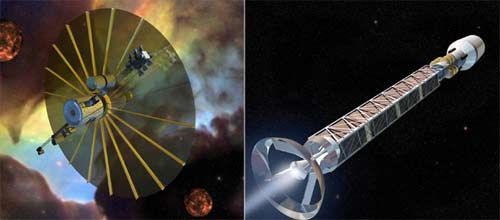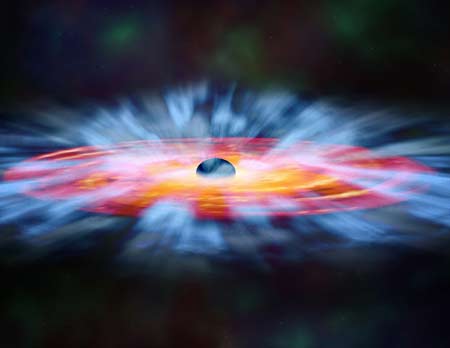The 10 strangest things of the universe
Black holes about the size of atomic nuclei, " carnivorous " galaxies, matter particles that can penetrate through tens of kilometers of lead are just some of the most shocking findings about lateral space. extraterrestrial.
Mysterious things in the universe
Antimatter
Like superheroes or bats, molecules that make up matter always have versions that are opposite to them. For example, an electron has a negative charge, but its antimatter, positron, has a positive charge. The matter and antimatter destroy each other when colliding and their mass turns into energy according to Einstein's formula E = mc 2 . In the future, some spacecraft will be equipped with antimatter engines.

(Photo: Space)
Tiny black holes
If a new theory of gravitational force is proven to be correct, it can be said that, scattered in our solar system are tens of thousands of microscopic black holes , each about the size of an atomic nucleus. . Unlike the giant black hole that is often mentioned, the tiny black hole is the remnant of the Big Bang - the event that was supposed to give birth to the universe. They affect space-time in a way completely different from the giant black hole due to its relationship to the fifth dimension in space.

Tens of thousands of "black holes" like this are scattered in the solar system.(Photo: Space)
Radiation remnants of the universe
Also known as CMB , this radiation is the original residue from the Big Bang explosion that gave birth to the universe. It was first discovered in the 1960s as a noise in the radio and seemed to radiate from everywhere in space. CMB is considered one of the best parts of evidence for Big Bang theory. Recent accurate measurements of the location of the WMAP project CMB temperature at -455 degrees F (-270 degrees C).

(Photo: Space)
Dark matter
Scientists think that black matter accounts for most of the matter in the universe. But even if they have the most modern technologies, they cannot prove it. It is thought that neutrinos are ultralight and black holes are not visible as part of black matter. Despite this, many astronomers still doubt its existence. They argue that the mysteries surrounding black matter can only be explained when we understand more about gravitational force.

Black matter.(Photo: Space)
Foreign planet
Until about the early 1990s, only known planets in the universe were familiar members of our solar system . Astronomers have identified more than 500 extrasolar planets (November 2010). They are classified to be from the giant gas world whose mass is just shy as the small star, the stone people revolve around red, dim dwarfs. Finding a second Earth, however, is still ongoing. Astronomers generally believe that technology is better than the ultimate ability to reveal the world like ours.

An alien planet is outside the solar system.(Photo: Space)
Gravity wave
From 1916, genius physicist Einstein predicted the existence of gravitational waves in his general theory of relativity. According to Einstein's definition, gravitational waves are geometric disturbances of space-time propagating at the speed of light.
Regarding the source, it is assumed that heavy objects and fast moving can emit gravitational waves, like the phenomenon of electromagnetic waves of charged particles. However, some argue that only non-spherical objects broadcast gravity. Because gravitational waves are so weak, scientists cannot create it in the laboratory. They were forced to rely on violent events in the universe, such as the merger of two black holes or two neutron stars, to measure this type of wave.

In terms of shape, gravitational waves are no different from waves on the water.(Photo: Space)
The " carnivores " in the universe
Like the creatures on Earth, galaxies can " eat " each other and so they evolve. Andromeda , a galaxy close to the Milky Way, is in the process of swallowing many of its satellites. Over a dozen constellations are scattered throughout Andromeda. Scientists think they are remnants left after the galaxies' meals ". The image on the right simulates the collision phenomenon between Andromeda and our Milky Way , a phenomenon that occurs only about 3 billion years.

The image simulates the collision phenomenon between the Andromeda galaxy and the Milky Way.(Photo: space)
Neutrino particles
They are the basic particles with neutral charge and almost no weight.Neutrinos can pass through a tens of kilometers of lead. Some neutrinos are going through your body when you read this article. These " ghosts " are created inside the stars' fires and supernova explosions of dying stars.

Neutrino particles.(Photo: Space)
Quasar (quasar)
They are celestial bodies with a diameter of less than one light-year but are the most powerful source of radiation. Even at the edge of the universe, the light of the quasars still reaches our planet. Their existence reminds scientists of the chaos in the early dawn of the universe. The energy that a quasar releases is much larger than the energy of hundreds of galaxies. The following is the only thing scientists agree on: quasars are giant black holes located in the center of distant galaxies.

Photo of a quasar called 3C 273, taken in 1979. (Photo: Space)
Vacuum energy
Quantum physics tells us that contrary to appearance, empty space is a "virtual " foam of subatomic particles that are constantly being created and destroyed. The particles travel to each centimeter of space with a certain energy, according to general relativity, creating a counterforce force that pushes space away. However, no one knows what is really causing the expansion to the very fast speed of the universe.

(Photo: Space)
- The things you do every day will become very 'weird' when you are in the universe
- 12 hottest things in the universe
- 6 common anecdotes about the universe far from reality
- 10 unknown things about life in the universe
- The 10 most mysterious things in the Solar System (part 1)
- 5 fascinating facts about the universe will
- What if you fell into a black hole in the universe?
- 5 great mysteries of the universe
- Unbelievable reasons for people to die outside the universe
- Little things to know about astronauts
- Blind eyesight - The strangest state of awareness
- We live in the end of the universe
 Van Allen's belt and evidence that the Apollo 11 mission to the Moon was myth
Van Allen's belt and evidence that the Apollo 11 mission to the Moon was myth The levels of civilization in the universe (Kardashev scale)
The levels of civilization in the universe (Kardashev scale) Today Mars, the sun and the Earth are aligned
Today Mars, the sun and the Earth are aligned The Amazon owner announced a secret plan to build a space base for thousands of people
The Amazon owner announced a secret plan to build a space base for thousands of people